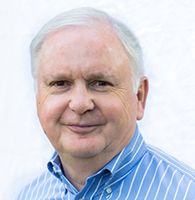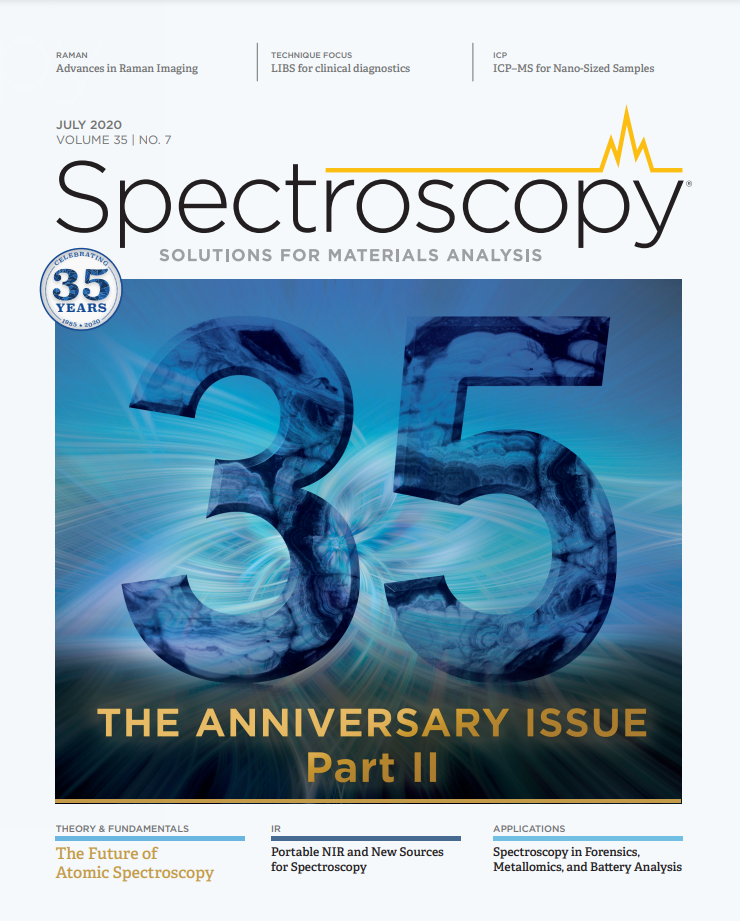The Future of Portable Spectroscopy
Spectroscopy
Portable spectroscopic instruments have not had significant visibility within the scientific community compared with, for instance, the current generation of high-performance laboratory mass spectrometers.
Portable spectroscopic instruments have not had significant visibility within the scientific community compared with, for instance, the current generation of high-performance laboratory mass spectrometers. This is attributable to a number of reasons, including their very applied (as opposed to research) nature, resulting in few publications in the refereed literature, and their predominant use by non-scientists. The numbers of these instruments deployed today can therefore come as a surprise. For instance, as early as the 1990s, more than 60,000 ion mobility spectrometers (IMS) were deployed worldwide. Cumulative handheld X-ray fluorescence (XRF) shipments today total more than 100,000, and portable Raman shipments number in the tens of thousands. For these, and some other categories of portable spectrometers, there are more instruments in the field than there are in laboratories.
The rationale for portable and handheld spectrometers is simple: allowing the spectrometer to be taken to the sample, as opposed to bringing the sample to the spectrometer, thereby moving the laboratory to the point of need-the location of the sample. Portable instruments provide the ability to make informed decisions on the spot, and by rapidly delivering actionable results at the point of need, you change or transform the way the customer does business, whether a hazardous materials (hazmat) technician, a scrap metal dealer, personnel in pharmaceutical manufacturing, or the military. To generate these actionable answers, the developers of these instruments have put extensive resources into reliable identification algorithms, spectroscopic libraries or databases, and qualitative and quantitative calibrations.
These instruments have dramatically increased their capabilities over the past 20 years, while at the same time becoming smaller and lighter. On one hand, this is due to all the developments in consumer electronics and computing power, and, on the other, to ongoing research and development (R&D) and manufacturing experience and innovation in the companies producing the instruments. Nonetheless, some challenges remain, and, as an example, we can look at portable Raman spectroscopy, especially in its safety and security applications.
All Raman spectroscopists, no matter what kind of samples they deal with, are aware of the potential for fluorescence inference. Excitation at 785 nm has been a good compromise between long and short wavelength excitation while still using lower cost, and lower noise, silicon-based detectors. There has been a recent trend to move to 1064 nm excitation, although a penalty is paid in terms of measurement time for comparable signal-to-noise spectra. Deep-ultraviolet (UV) excitation is intriguing, especially for standoff detection, but brings along its own issues, and obviously does not work with glass containers. Various shifted-excitation schemes are also in use, and time-gating is commercially available in a laboratory instrument. It’s not clear if there is a “best approach,” or what a universal solution, could be.
Standoff detection is of obvious benefit for the military and other practitioners dealing with potential explosives or highly toxic materials. Truck- and backpack-mounted instruments have existed for some time, often using deep-UV excitation, which has the benefit of being able to use solar-blind detectors. But this technology is still relatively immature, and has issues related to the lifetime of key components. A handheld spectrometer operating at 830 nm excitation, capable of a one-meter standoff, has recently been announced, and that represents the first true handheld device of this kind. Sample heating is a concern for potentially explosive samples, as is the pressure required to obtain good spectra using portable Fourier-transform infrared (FT-IR) instrumentation with diamond attenuated total reflectance (ATR) sampling. Sample heating is being addressed in schemes involving motion of the laser spot over the sample.
Real-life samples are most often mixtures, and this challenge is being addressed with a combination of library and algorithm development, aided by improvements in mobile processing power and memory, and also with the possibility of wireless communications and cloud processing. Finally, examination of a sample contained in packaging is desirable, in areas as different as pharmaceutical incoming raw material inspection, smuggling of contraband into prisons, and detection of potential explosives at airport checkpoints. Spatially-offset Raman spectroscopy can address that issue for many packaging materials (not metals, though!), and other methods have been developed.
Finally, the shrinking size and increased performance of these Raman instruments lends them to “hyphenation” or “combination” with other portable spectrometers. A combined Raman–FT-IR instrument has been on the market for several years now, but combinations like Raman–NIR, Raman–XRF, and Raman with laser-induced breakdown spectroscopy (LIBS) are also possible. Indeed, the next year or two should see the launch of both U.S. and European Mars missions, with Raman and LIBS capabilities, a fantastic example of portable and standoff spectroscopy. We shouldn’t forget that a gas chromatography–mass spectrometry (GC–MS) instrument was on a Viking mission to Mars in the late 1970s, and that FT-IR instruments were on the two Voyager missions, launched in late 1970s, continuing on their planetary tours throughout the 1980s. Hyperspectral instruments have also been shrinking in size, especially those based on silicon detectors. Handheld and drone-mounted versions are now available, and we will can anticipate increasing applications of those instruments in the future.
So we can expect to see developments in all of these areas, and also significant diminution of the size of these instruments. Today, a Raman instrument about 1” x 1” x 1” in size is possible. This is a far cry from the scanning triple monochromator, argon ion excitation, photomultiplier detection, and chart paper output instrument I used for my PhD studies!
All of the capabilities described above come from instruments developed by the major analytical instrument companies, or by smaller companies and institutions under government contracts. Recent years have seen the start of a new market segment, enabled by the very low cost of ambient temperature, silicon-based, detectors, especially the cameras in smartphones. Small, portable, low-cost spectrometers operating in the visible region have been available for many years, used, for instance, in colorimetric analysis of water, and color matching (such as paint). One research thread has been to investigate whether existing clinical analyses and assays can be adapted to smartphones, enabling this work to be done at the point-of-care, potentially in remote areas with very limited infrastructures. This research leverages existing “chemistries” (that is, established reagents and procedures), microfluidics, and both the spectroscopic potential of smartphone cameras, and their inherent processing power and communications abilities. This was the topic of a recent Pittsburgh Conference Symposium, organized by the Society for Applied Spectroscopy (SAS). Also featured in that symposium was a detailed description of the capabilities of smartphone cameras, and what is required to obtain good spectroscopic data from them. This leads to the possibility of scientific organizations equipping members of the public with accessories and software for their phones, and then coordinating “citizen science” studies involving thousands of people. Work is going on in this area in The Netherlands, following on from a project a few years ago measuring atmospheric aerosols, in which over 3000 members of the public participated.
However, there are also new companies marketing devices in the visible-to-~1000 nm region directly to the public, and making wide claims about their analytical capabilities. Although there is obviously interest in the general public to be able to analyze materials, including food and medicines, there are numerous significant issues here. The first is whether there is appropriate information in the spectral region covered. You can obviously match colors, and you can certainly examine classes of compounds like lycopenes and carotenoids in fruits and vegetables. But general food analysis has traditionally used the near infrared, especially the 1000– 1700 nm region, where overtone and combination bands are much stronger. (This author has even seen a claim to assay gold using a low cost visible spectroscopy device, something that is straightforward using handheld or portable XRF, but impossible in the visible region of the spectrum!) Second, foods, in particular, are highly heterogeneous, and laboratory instruments typically employ large sample areas, often combined with sample spinners or integrating spheres for their measurements. Third, the interrogation of foods using a handheld instrument, especially by an untrained operator, can be highly irreproducible, giving erroneous results. Fourth, years of experience in the near-infrared community have shown the need for careful and validated calibrations, to eliminate the possibility of accidental correlations when limited sample sets are used. Fifth, some of these new vendors seem to be relying on “crowd-sourced” data. Sixth, there seems to be a lack of understanding about the possible detection limits of optical spectroscopy in the condensed phase, with claims to detect trace amounts, such as allergens, pathogens, pesticide and herbicide residues, and so on. With all the issues noted above, and the lack (most likely) of reference analyses, the potential for “garbage in, garbage out” analyses is extremely high. This list of caveats can go on and on, but suffice it to say this is an area of concern, with the potential to mislead the general public, with even fatal consequences.
To sum up, portable and handheld spectroscopy is a rapidly growing area, with instruments spanning the electromagnetic spectrum from the X-ray region to the mid-infrared, and ranging in techniques from GC–MS to nuclear magnetic resonance (NMR) relaxometry. Instruments are becoming smaller, lighter, and more capable, but we still have to understand the basic analytical spectroscopy concepts of sampling, heterogeneity, detection limits, signal-to-noise, and so on.
Further Reading
This short article does not contain any references; for those the reader is directed to this author’s recent review article: Richard A. Crocombe, “Portable Spectroscopy”, Appl. Spectrosc. 72(12), 1701–1751 (2018). https://doi.org/10.1177/0003702818809719

Richard A. Crocombe is the principal of Crocombe Spectroscopic Consulting, and the 2020 President of the Society for Applied Spectroscopy. Direct correspondence to racrocombe@gmail.com

AI-Powered SERS Spectroscopy Breakthrough Boosts Safety of Medicinal Food Products
April 16th 2025A new deep learning-enhanced spectroscopic platform—SERSome—developed by researchers in China and Finland, identifies medicinal and edible homologs (MEHs) with 98% accuracy. This innovation could revolutionize safety and quality control in the growing MEH market.
New Raman Spectroscopy Method Enhances Real-Time Monitoring Across Fermentation Processes
April 15th 2025Researchers at Delft University of Technology have developed a novel method using single compound spectra to enhance the transferability and accuracy of Raman spectroscopy models for real-time fermentation monitoring.